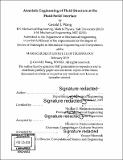| dc.contributor.advisor | Nicolas G. Hadjiconstantinou. | en_US |
| dc.contributor.author | Wang, Gerald J.(Gerald Jonathan) | en_US |
| dc.contributor.other | Massachusetts Institute of Technology. Department of Mechanical Engineering. | en_US |
| dc.date.accessioned | 2019-07-19T19:42:02Z | |
| dc.date.available | 2019-07-19T19:42:02Z | |
| dc.date.copyright | 2019 | en_US |
| dc.date.issued | 2019 | en_US |
| dc.identifier.uri | https://hdl.handle.net/1721.1/121850 | |
| dc.description | Thesis: Ph. D. in Mechanical Engineering and Computation, Massachusetts Institute of Technology, Department of Mechanical Engineering, 2019 | en_US |
| dc.description | Cataloged from PDF version of thesis. | en_US |
| dc.description | Includes bibliographical references (pages 131-141). | en_US |
| dc.description.abstract | Under extreme confinement, fluids exhibit a number of remarkable effects that cannot be predicted using macroscopic fluid mechanics. These phenomena are especially pronounced when the confining length scale is comparable to the fluid's internal (molecular) length scale. Elucidating the physical principles governing nanoconfined fluids is critical for many pursuits in nanoscale engineering. In this thesis, we present several theoretical and computational results on the structure and transport properties of nanoconfined fluids. We begin by discussing the phenomenon of fluid layering at a solid interface. Using molecular-mechanics principles and molecular-dynamics (MD) simulations, we develop several models to characterize density inhomogeneities in the interfacial region. Along the way, we introduce a non-dimensional number that predicts the extent of fluid layering by comparing the effects of fluid-solid interaction to thermal energy. | en_US |
| dc.description.abstract | We also present evidence for a universal scaling relation that relates the density enhancement of layered fluid to the non-dimensional temperature, valid for dense-fluid systems. We then apply these models of fluid layering to the problem of anomalous fluid diffusion under nanoconfinement. We show that anomalous diffusion is controlled by the degree of interfacial fluid layering; in particular, layered fluid exhibits restricted diffusive dynamics, an effect whose origins can be traced to the (quasi-) two dimensionality and density enhancement of the fluid layer. We construct models for the restricted diffusivity of interfacial fluid, which enables accurate prediction of the overall diffusivity anomaly as a function of confinement length scale. Finally, we use these earlier developments to tackle the notorious problem of dense fluid slip at a solid interface. | en_US |
| dc.description.abstract | We propose a molecular-kinetic theory that formulates slip as a series of thermally activated hops performed by interfacial fluid molecules, under the influence of the bulk fluid shear stress, within the corrugated energy landscape generated by the solid. This theory linearizes to the Navier slip condition in the limit of low shear rate, captures the central features of existing models, and demonstrates excellent agreement with MD simulation as well as experiments. | en_US |
| dc.description.statementofresponsibility | by Gerald J. Wang. | en_US |
| dc.format.extent | 141 pages | en_US |
| dc.language.iso | eng | en_US |
| dc.publisher | Massachusetts Institute of Technology | en_US |
| dc.rights | MIT theses are protected by copyright. They may be viewed, downloaded, or printed from this source but further reproduction or distribution in any format is prohibited without written permission. | en_US |
| dc.rights.uri | http://dspace.mit.edu/handle/1721.1/7582 | en_US |
| dc.subject | Mechanical Engineering. | en_US |
| dc.title | Atomistic engineering of fluid Structure at the fluid-solid interface | en_US |
| dc.type | Thesis | en_US |
| dc.description.degree | Ph. D. in Mechanical Engineering and Computation | en_US |
| dc.contributor.department | Massachusetts Institute of Technology. Department of Mechanical Engineering | en_US |
| dc.identifier.oclc | 1102316334 | en_US |
| dc.description.collection | Ph.D.inMechanicalEngineeringandComputation Massachusetts Institute of Technology, Department of Mechanical Engineering | en_US |
| dspace.imported | 2019-07-19T19:41:48Z | en_US |
| mit.thesis.degree | Doctoral | en_US |
| mit.thesis.department | MechE | en_US |
